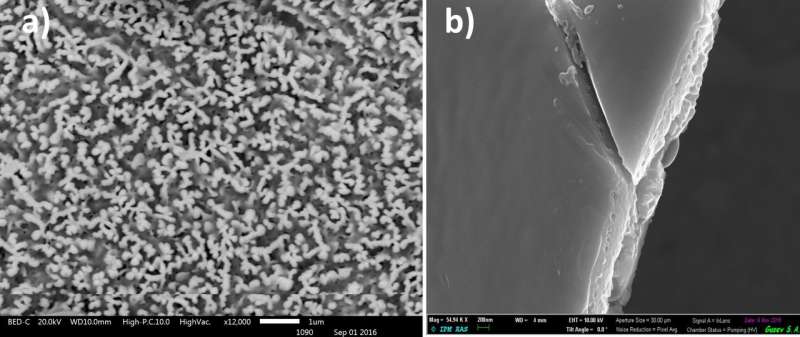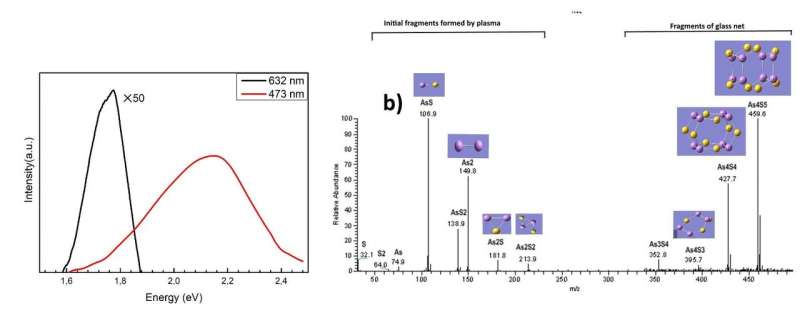Optical emission of two-dimensional arsenic sulfide prepared in plasma

Since the discovery of graphene in 2004, there has been a rapidly growing interest among scientists in the study of 2-D materials beyond graphene. In the family of chalcogenide materials, 2-D-layered transition-metal dichalcogenides demonstrate excellent electronic and optical properties, outstanding mechanical flexibility, and exceptional catalytic performance. At the same time, chalcogenides like As2S3, As2Se3, etc., have never been considered as materials capable of forming structures of this type.
It could be due to the limitations of the methods used for preparing those materials. A group of researchers from the laboratory of functional nanomaterials at the Lobachevsky State University of Nizhny Novgorod, the Alekseev Nizhny Novgorod State Technical University and the AGH University of Science and Technology (Krakow, Poland) have demonstrated the possibility of forming honeycomb structural fragments in plasma using the two-dimensional arsenic sulfide chalcogenide systemin. They have reported their findings in a study titled "Infrared and Raman spectroscopy study of As-S chalcogenide films prepared by plasma-enhanced chemical vapor deposition."
They report a strong structural photoluminescence excited by continuous wave operation lasers with a wavelength of 473 nm and 632.8 nm. The influence of excitation parameters, chemical composition, structure, and annealing conditions on the intensity of photoluminescence of the chalcogenide materials has been established. Mass-spectrometry and Raman spectroscopy were coupled with quantum-chemical calculations to reveal the fragments which are the building blocks of the 2-D As-S materials.
The researchers propose a plausible mechanism of formation and modification of the arsenic sulfide luminescent structural units. The properties of 2-D pole-structured and layered arsenic sulfide are suggested to be the key to advancing to 2-D photosensitive devices.
Scanning electron microscopy (SEM) images typical of the arsenic sulfide with a composition As40S60 are illustrated in Figure 1 (a) and (b). The striking difference in the surface morphology and structure is due to very different conditions of plasma deposition.

Both pictures (1a and 1b) illustrate arsenic sulfide structures consisting of (As2S2)n-units formed in plasma by spherical structural fragments with a diameter of about 100 nm. Figure 1a shows a pole-structured material and Figure 1b depicts a 2-D layered structure, the theoretical possibility of which has been described recently. The researchers report quantum-chemical estimations of these structures together with experimental results on the unusually broad transparency window of these materials (0.43—20 μm) in comparison with those of As2S3 (0.6—11 μm) prepared by traditional thermal methods.
Photoluminescence of the plasma-prepared arsenic sulfide was measured by excitation at 473 nm and 632.8 nm employing continuous wave operation lasers at room temperature (RT, Figure 2). The arsenic sulfide materials prepared in plasma were analyzed using the mass-spectrometry method to reveal the main structural fragments affecting the luminescence intensity. The mass-spectroscopy data clarify the main structural fragments affecting the PL intensity of the plasma-prepared arsenic sulfide. According to the data obtained, the researchers suggest that the main reason for the appearance and enhancing of the luminescence in arsenic sulfide materials prepared in plasma is the (As2S2)n cyclic structure unit playing the role of a "disk-like polarizability tensor."
Due to its properties, two-dimensional pole-structured and layered arsenic sulfide is a promising material for developing 2-D photosensitive devices. These properties are also useful when creating field-effect transistors, highly sensitive photodetectors and gas sensors.
Provided by Lobachevsky University





















